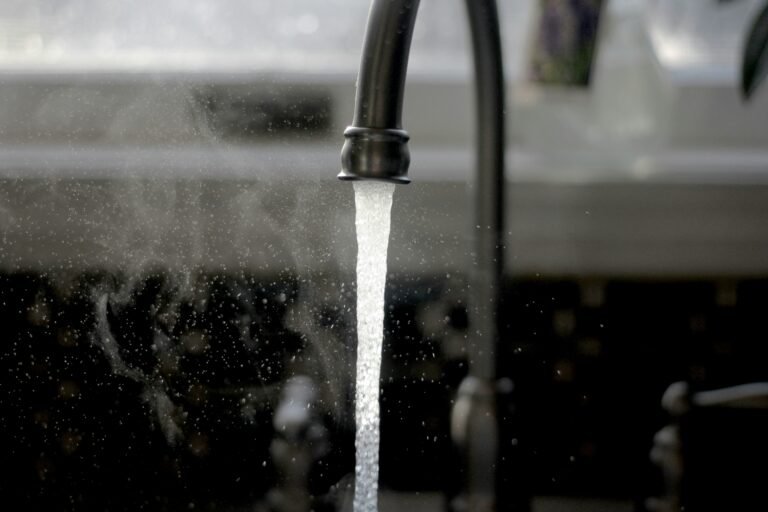Upgrade your bathroom with touchless faucets that save water and boost hygiene.
Touchless faucets improve hygiene and cut water waste. Research by the Water Conservation Council shows these systems can reduce water use by 30% in many cases.
These faucets help reduce germ spread in both homes and public spaces. They also lower water bills by automatically shutting off when not needed.
This guide explains the benefits of touchless faucets. It covers features, varieties, selection tips, proper usage, and maintenance advice for both residential and commercial settings.
Understanding Touchless Bathroom Faucets
Touchless faucets work with sensors that detect movement. They turn the water on and off automatically. This feature minimizes contact and helps stop germ spread.
- They prevent germs by removing the need to touch handles.
- Public restrooms benefit from fewer bacteria on faucets.
- Studies show households can save up to 30% on water use.
Key Features and Capabilities
These faucets include features that boost convenience and efficiency. Knowing these can help you choose the right model.
- Sensor sensitivity adjusts to detect hands accurately.
- Temperature control lets you set a comfortable water warmth.
- Power options include battery and AC models for easy installation.
Comparing Varieties and Options
Many types of touchless faucets exist. Below is a comparison to simplify your decision.
| Feature/Type | Benefits | Best For | Considerations |
|---|---|---|---|
| Battery-Operated | Easy installation with no need for electrical work | Residential bathrooms | Requires periodic battery replacements |
| AC-Powered | Consistent power and no battery worries | Commercial restrooms | Needs an electrical outlet nearby |
Guiding Your Selection
Follow these steps to pick the ideal touchless faucet for you.
- Check your location to decide between battery or AC power.
- Assess user needs for sensor sensitivity and temperature control.
- Match the faucet style and function with your bathroom design.
Usage and Implementation
Proper installation and use help you enjoy the benefits of touchless faucets. Use these tips for best results:
- Calibrate sensors for smooth performance.
- Regularly check power sources for reliable operation.
- Inform users how the sensor technology works for proper usage.
Care and Maintenance
Good care extends the life of your touchless faucet. Follow these simple steps:
- Clean the sensor lenses often to keep them working well.
- Replace batteries or check AC connections regularly.
- Inspect for leaks and wear to avoid damage.
Expert Tips and Recommendations
- Select a model with adjustable sensor sensitivity for different settings.
- Install touchless faucets in high-traffic areas to boost hygiene.
- Carry out regular maintenance checks to catch issues early.
- Opt for models with water-saving technology to protect the environment.
Common Questions About Touchless Bathroom Faucets: Hygienic and Water-Saving Solutions
Below are answers to common questions about touchless faucets.
- Q: How do touchless faucets save water?
A: They shut off automatically when not in use, which cuts water waste. - Q: Are touchless faucets hard to install?
A: No, they often have a simple setup, especially battery models. - Q: Can they fit any sink?
A: Most models work with standard sinks, but check the specs first. - Q: How long do they last?
A: With proper care, they last as long as traditional faucets, around 10-15 years. - Q: Do they need special cleaners?
A: No, regular non-abrasive cleaners work fine.
Conclusion
A good sensor faucet should feel effortless, stay clean with less contact, and use only the water you need. Put reliability and safety first. If detection is consistent, the flow rate is right for your basin, and the temperature is controlled, you improve hygiene and cut your bill without losing comfort.
Quick checks before you buy
-
Detection that you can tune. Look for adjustable range and delay so the water does not trigger from mirror glare or sleeves.
-
Power that suits your room. Batteries for simple installs with a clear change interval, or mains power where an outlet is available.
-
Temperature control. A built-in mixing valve or a compatible under-sink valve with a maximum temperature limiter to reduce scald risk.
-
Published flow rate in gallons per minute or litres per minute that meets your local rules and matches a small bathroom basin to avoid splashing.
-
Auto shutoff time and maximum run time to stop continuous flow if the sensor is blocked.
-
Materials and finish. Lead-free brass or high-grade stainless for wet parts, a finish that resists spots, and metal-braided supply hoses.
-
Easy upkeep. A removable aerator, an inlet filter you can rinse, and spare parts with a clear warranty.
-
Fit check. Deck hole size, deck thickness range, spout reach that lands at the center of your basin, and clearance under mirrors or shelves.
Use and care for long life
-
Calibrate the sensor after installation, then test with wet and soapy hands.
-
Clean the sensor window with a soft cloth and mild soap. Avoid abrasive pads.
-
Rinse the aerator and inlet filter if the stream weakens or spray becomes uneven.
-
Replace batteries on a schedule before they fail. For mains power, check the plug and transformer during seasonal cleaning.
-
Wipe the finish dry after each deep clean to prevent mineral spots.
Next step
Measure your basin and deck, note where power will come from, then shortlist two or three models that list both adjustable detection and a maximum temperature limiter. Read the manual to confirm maintenance steps and install the one that gives a steady stream without splashing at your typical hand-washing height.
Check out this related post: Touchless Bathroom Faucets: Hygienic Water Control
Explore this topic: Bathroom Technology
Design rooms with AI Home Design
This article contains affiliate links. If you make a purchase, we may earn a commission at no extra cost to you.
Last updated on August 31, 2025








